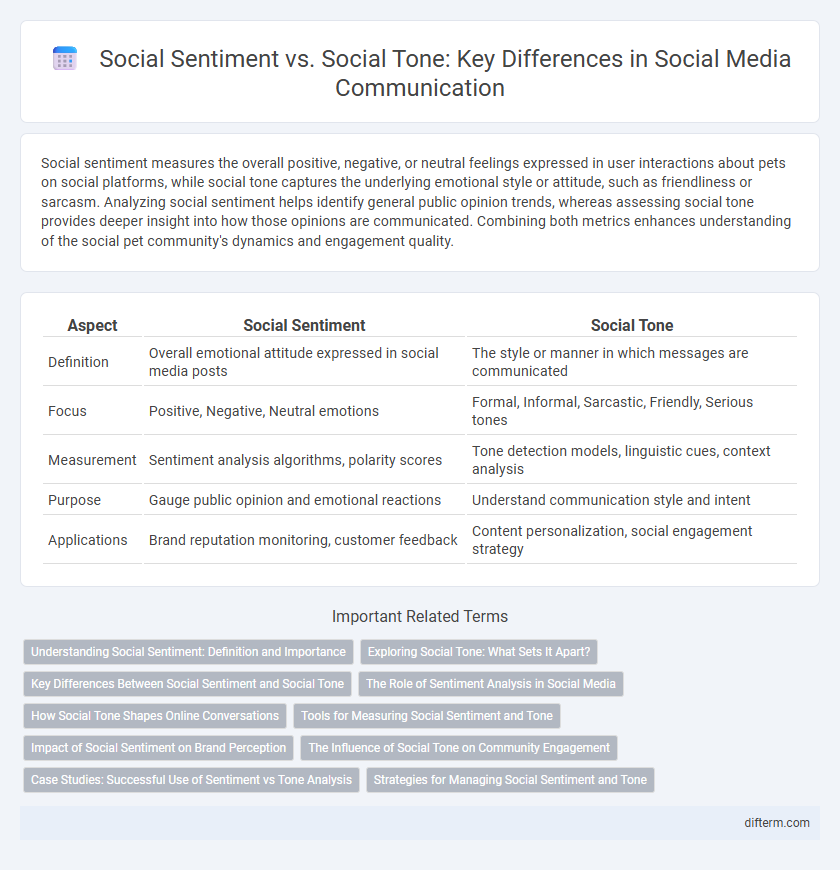Social sentiment measures the overall positive, negative, or neutral feelings expressed in user interactions about pets on social platforms, while social tone captures the underlying emotional style or attitude, such as friendliness or sarcasm. Analyzing social sentiment helps identify general public opinion trends, whereas assessing social tone provides deeper insight into how those opinions are communicated. Combining both metrics enhances understanding of the social pet community's dynamics and engagement quality.
Table of Comparison
| Aspect | Social Sentiment | Social Tone |
|---|---|---|
| Definition | Overall emotional attitude expressed in social media posts | The style or manner in which messages are communicated |
| Focus | Positive, Negative, Neutral emotions | Formal, Informal, Sarcastic, Friendly, Serious tones |
| Measurement | Sentiment analysis algorithms, polarity scores | Tone detection models, linguistic cues, context analysis |
| Purpose | Gauge public opinion and emotional reactions | Understand communication style and intent |
| Applications | Brand reputation monitoring, customer feedback | Content personalization, social engagement strategy |
Understanding Social Sentiment: Definition and Importance
Social sentiment refers to the emotional attitude or opinion expressed by individuals within social media and online platforms, often analyzed through natural language processing to gauge public mood. Understanding social sentiment is crucial for brands and organizations to identify consumer feelings, monitor reputation, and adapt strategies in real-time. Unlike social tone, which reflects the style or manner of communication, social sentiment captures the underlying emotional value of messages, enabling more accurate insights into public perception.
Exploring Social Tone: What Sets It Apart?
Social tone reflects the emotional quality underlying communication, capturing nuances like sarcasm, humor, or empathy that influence message perception. Unlike social sentiment, which categorizes content as positive, negative, or neutral, social tone delves deeper into the contextual subtleties shaping user interactions. Understanding social tone enables brands to tailor responses authentically and foster meaningful engagement across diverse social platforms.
Key Differences Between Social Sentiment and Social Tone
Social sentiment measures the overall emotional attitude of a group toward a subject, often categorized as positive, negative, or neutral based on collective opinions. Social tone captures the style and mood of communication in social interactions, reflecting nuances such as formality, enthusiasm, or sarcasm in the language used. Key differences lie in sentiment's focus on aggregated emotional polarity, while tone emphasizes the qualitative expression and contextual style of social discourse.
The Role of Sentiment Analysis in Social Media
Sentiment analysis in social media plays a crucial role in interpreting public opinion by categorizing textual data into positive, negative, or neutral emotions, enabling businesses and organizations to gauge consumer mood accurately. Unlike social tone, which reflects the stylistic and emotional flavor of communication, sentiment analysis quantifies emotional polarity across large datasets to identify trends and potential crises in real-time. This data-driven approach supports targeted marketing strategies and enhances customer engagement by understanding collective feelings and reactions on platforms like Twitter, Facebook, and Instagram.
How Social Tone Shapes Online Conversations
Social tone profoundly influences the nature and flow of online conversations by setting the emotional context in which messages are interpreted. Positive tones foster engagement and community building, while negative tones can escalate conflicts and reduce collaboration. Understanding social tone helps platforms and users modulate interactions to maintain constructive and respectful digital environments.
Tools for Measuring Social Sentiment and Tone
Tools for measuring social sentiment and tone analyze linguistic cues and emotional expressions in online content to gauge public opinion and mood accurately. Advanced AI-driven platforms utilize natural language processing (NLP) and machine learning algorithms to differentiate between positive, negative, and neutral sentiments while identifying nuances in sarcasm, irony, and humor. Integrating these tools enables businesses and researchers to make informed decisions by capturing the subtleties of social interactions across various digital channels.
Impact of Social Sentiment on Brand Perception
Social sentiment reflects the overall emotional response consumers express towards a brand on platforms like Twitter and Facebook, directly influencing public opinion and brand reputation. Positive social sentiment drives higher engagement, increased customer loyalty, and enhanced brand equity, while negative sentiment can lead to reduced trust and diminished market value. Monitoring social sentiment with advanced analytics enables brands to respond strategically, mitigating risks and capitalizing on opportunities to strengthen their market position.
The Influence of Social Tone on Community Engagement
Social tone significantly shapes community engagement by influencing emotional responses and fostering a sense of belonging among members. Positive tones encourage participation, trust, and collaboration, while negative tones can lead to disengagement and conflict within online communities. Understanding and strategically managing social tone enhances user interaction and nurtures a supportive, vibrant social environment.
Case Studies: Successful Use of Sentiment vs Tone Analysis
Case studies in social media analytics reveal that sentiment analysis effectively measures public opinion polarity, identifying positive, negative, or neutral attitudes, whereas social tone analysis captures the emotional context and interpersonal style, such as humor, sarcasm, or professionalism. Brands like Coca-Cola and Netflix optimize customer engagement by integrating sentiment data with tone insights, enhancing message resonance and crisis management strategies. Research shows that combining both analyses provides a comprehensive understanding of online conversations, leading to more precise targeting and improved social media campaign outcomes.
Strategies for Managing Social Sentiment and Tone
Effective strategies for managing social sentiment involve continuous monitoring of online conversations using advanced sentiment analysis tools to identify positive, neutral, and negative emotions associated with a brand. Crafting appropriate responses that align with the desired social tone requires a clear understanding of the audience's cultural context and communication style. Implementing proactive engagement practices, such as timely replies and consistent messaging, helps maintain a balanced social tone and enhances overall brand reputation.
social sentiment vs social tone Infographic

 difterm.com
difterm.com